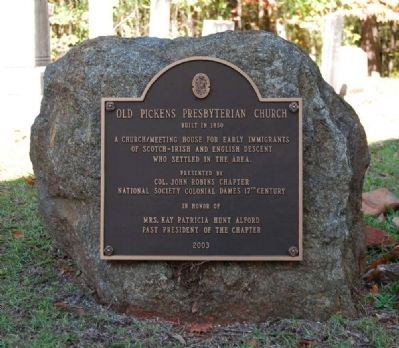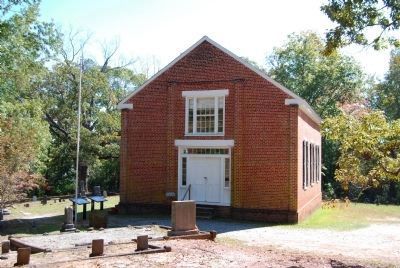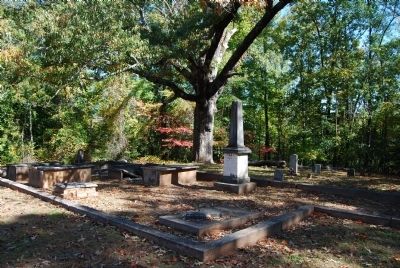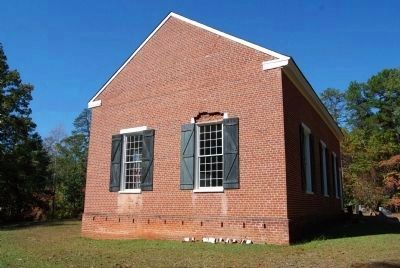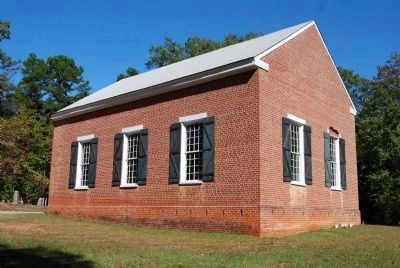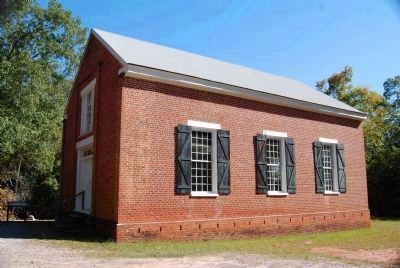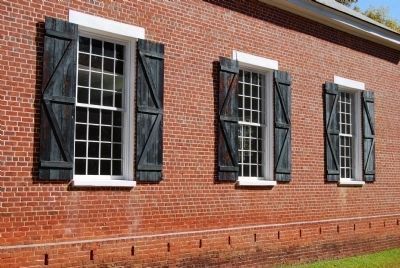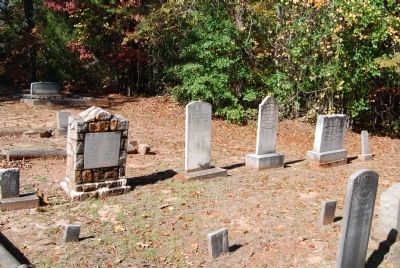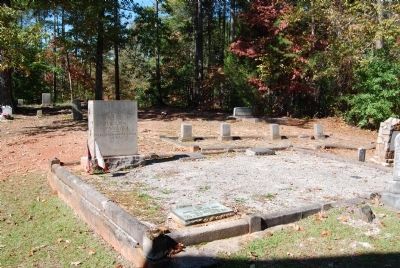Seneca in Oconee County, South Carolina — The American South (South Atlantic)
Old Pickens Presbyterian Church
Built in 1850
— American Presbyterian and Reformed Historical Site —
of Scotch-Irish and English descent
who settled in the area.
Presented by
Col. John Robins Chapter
National Society Colonial Dames 17th Century
In Honor of
Mrs. Kay Patricia Hunt Alford
Past President of the Chapter
Erected 2003 by Col. John Robins Chapter, National Society Colonial Dames 17th Century. (Marker Number 401.)
Topics and series. This historical marker is listed in these topic lists: Churches & Religion • Settlements & Settlers. In addition, it is included in the American Presbyterian and Reformed Historic Sites series list.
Location. 34° 47.483′ N, 82° 53.167′ W. Marker is in Seneca, South Carolina, in Oconee County. Marker is on East Pickens Highway (State Highway 183). Marker faces the front (north) entrance of the church. Touch for map. Marker is in this post office area: Salem SC 29676, United States of America. Touch for directions.
Other nearby markers. At least 8 other markers are within 5 miles of this marker, measured as the crow flies. Old Pickens Church (within shouting distance of this marker); a different marker also named Old Pickens Presbyterian Church (within shouting distance of this marker); Andrew Pickens (within shouting distance of this marker); Henry Craig (about 400 feet away, measured in a direct line); Furman L. Smith Memorial Highway (approx. 3.9 miles away); Six Mile Veterans Monument (approx. 3.9 miles away); Cherokee Path (approx. 3.9 miles away); Fort Prince George (approx. 4.6 miles away). Touch for a list and map of all markers in Seneca.
Regarding Old Pickens Presbyterian Church. Old Pickens Presbyterian Church was listed in the National Register of Historic Places in 1996. This church is also one of 445 American Presbyterian and Reformed Historical Sites registered between 1973 and 2003 by the Presbyterian Historical Society (PHS), headquartered in Philadelphia. Approved sites received a metal plaque featuring John Calvin’s seal and the site’s registry number (PHS marker location unknown).
The following text is taken from the Presbyterian Historical Society website:
Old Pickens Presbyterian Church, established in 1830, was the first congregation in the town of Pickens Court House. Local historians estimate that the church was constructed between 1847 and 1851. When Pickens County was divided in 1868 to form Oconee County,
the courthouse moved and the town went into decline. Local Presbyterians stopped using the church building by the 1910s. Today, the one-story brick building is all that remains of the once-thriving town. The church property includes a cemetery with 217 graves. The cemetery appears to precede the church building with the earliest gravestone belonging to Revolutionary War veteran Lt. Joseph Reid (1750-1825).
Also see . . . Old Pickens Presbyterian Church. Wikipedia entry:
Old Pickens Presbyterian Church is a historic church in Seneca, South Carolina. (Submitted on May 8, 2012, by Brian Scott of Anderson, South Carolina.)
Additional commentary.
1. Old Pickens Presbyterian Church - National Register Nomination Form (1996)
Old Pickens Presbyterian Church, constructed in 1849-1851, is a two-story, rectangular, brick building with a gable roof, and is located off S.C. Highway 183, approximately one-quarter-mile west of the boundary line separating Oconee and Pickens Counties. It was built in the style of a typical mid-nineteenth century meeting house. The building has had only minor alterations since its construction and retains a high level of architectural integrity.
The brick walls of the church rest on a solid brick foundation pierced by regularly spaced openings for ventilation. The roof has a boxed cornice with returns; a small brick flue is located near the north end of the northwest roof slope. The church was wired for electricity in the 1940s, but there is no running water or modern plumbing in the building and the electricity has since been disconnected. The wood shingle roof was replaced in the early 1960s with wood sheathing, sawed from timber cut from the property, and covered with asphalt shingles. A new shingle roof was installed in 1989. Through the years necessary painting has been done, for the most part, by local citizens interested in the preservation of the building.
The façade (southeast elevation) has a central double-door entrance with sidelights and transom. A paired window above the door provides light to the interior gallery. Simple brick pilasters frame the entrance and extend from the foundation to a brick belt course about the gallery window. Similar pilasters are located at each end of the façade.
Each side elevation contains three sixteen-over-sixteen windows. The northwest elevation also has a single door entrance at its western end, providing access to the gallery. The rear (northwest) elevation has two sixteen-over-sixteen windows. All windows and the side door are intact but have been boarded to protect the building from vandalism. Each door and window is surmounted by a simple
wood lintel.
The interior of the church is well-preserved. The walls are finished in plaster applied over the brick. The original pine floor is intact, as are the original unpainted pews constructed of poplar and pine. A small platform at the southeast end of the building leads to a built-in pulpit. A gallery extends across the southwest end of the building and is supported by large columns. A Celotex ceiling was installed in the 1940s over the original wood ceiling was installed in the 1940s over the original wood ceiling. Though the wood stove has been stolen, the flue is still intact. The church’s original collection plates – actually cloth pickets attached to long wooden handles – are stored off site for protection; though the cloth has long since been replaced, the handles are original.
The church was probably constructed by volunteer labor and with donated materials. Oral history holds that the bricks were fired by riverbank clay in the bottoms of the Keowee River across the road from the church.
A cemetery containing over 200 marked graves is also located to the rear and sides of the church. In the original section, the earliest marked gravestones, that of American Revolution veteran Lieutenant Joseph Reed, dates from ca. 1825. The newer section of the cemetery dates from 1967, when graves were relocated here from cemeteries in locations flooded by the construction of a dam on the Keowee River. Records indicate 217 internments, some marked with elaborate gravestones and others with simple fieldstones.
The setting around the church has become increasingly rural and isolated since the old town of Pickens was abandoned, and nothing but the church remains to mark the site of Old Pickens.
Significance
Old Pickens Presbyterian Church, built 1849-1851, is significant as an excellent example of a mid-nineteenth century church built in the meeting house style and constructed of brick rather than the more common frame construction. It is also significant for its association with the mid-nineteenth century town of Pickens Court House (now often called Old Pickens) and as the only extant building surviving from the old town site.
Pickens Court House was established in 1828 to serve as the seat for Pickens District, a new judicial district created from Pendleton District. Pickens Court House was never a large town, and only has a little over one hundred inhabitants by 1860, when it boasted the courthouse, several shops and stores, an academy, a news paper (the Keowee Courier), a hotel, a stable, a school, a jail, a Masonic lodge, and a church – Old Pickens Presbyterian Church, which was the only church ever active in the town and where worship was open to Christians of all denominations.
Pickens Presbyterian Church, with fourteen members and two ruling elders, was accepted into the Presbytery of South Carolina in 1847, and construction began on this sanctuary soon afterwards. An 1858 deed states that the building belonged “to the denomination to be used by such other orthodox denominations of Christians as may choose to worship therein.”
In 1868 the town of Pickens Court House was abandoned when Pickens District was divided into Oconee and Pickens Counties and a new town – present-day Pickens – was established approximately fifteen miles northeast to serve as the seat of the new Pickens County. Most of the buildings in the old town of Pickens were town down or dismantled and moved to the new town of Pickens or to Walhalla. By 1875 one newspaper account stated that the only buildings still standing in Old Pickens were a few houses, the academy, and Pickens Presbyterian Church.
After the abandonment of Pickens Court House, activity at Old Pickens Presbyterian Church – renamed in 1883 to avoid confusion with the Presbyterian congregation in the new town of Pickens – declined, though the church continued to serve not only its own congregation but also area Methodist and Baptist congregations as well at various times. The Presbyterians ceased holding regular services here after 1919, but periodic homecomings, reunions, and special services were held here from the 1920s to the 1960s. The congregation of Pickens Presbyterian Church, consisted of only two members – Furber Lawrence Whitmire and Hettie Guntharp Whitmire, who had settled nearby along the Keowee River after World War I and farmed there – was officially dissolved by the Presbytery of the Piedmont (now Foothills Presbytery) in 1968. The Old Pickens Presbyterian Church Perpetual Care Committee, a group of area Presbyterians interested in the preservation of the church, organized in 1984 and maintains the sanctuary and cemetery with help from the Foothills Presbytery. (Source: National Register nomination form.)
— Submitted May 8, 2012, by Brian Scott of Anderson, South Carolina.
2. Preserving the Past to Look Toward the Future
Foothills Mission and News Report
By Sue H. Poss
June 2005
Old Pickens Presbyterian Church is the last remaining building of the town that was Old Pickens. And members of the Historic Old Pickens Foundation Board want to make sure the building is around for years to come.
The board has begun the first phase of a renovation project that includes strengthening floor joists and replacing a part of the flood with matching pine boards. The artificial ceiling is being removed.
The church is the only remaining building of the town that was the economic, political, and religious center of the Pickens District until 1868 when it was divided into Pickens and Oconee Counties. In addition to the church and cemetery, the thriving little town, originally called Pickens Court House, included six mercantile establishments, a newspaper, a doctor's office, several law offices, blacksmith shops, a jail, a Masonic Lodge, a Post Office, and a school.
The HOPF Board is considering whether, in the future, it will be possible to locate the buried foundations of these former structures.
This interior renovation is being funded by a $3000 grant from Region One of the South Carolina Heritage Corridor matched by funds of the HOPF Board. The Church and Cemetery are named sites on the Corridor. Visitors to this site will find two large plaques erected by the Heritage Corridor that recount the history of the town of Pickens Court House and provide some information about General Andrew Pickens for whom the town was named.
The immediate goal is interior renovation of the Church. Members of the Maintenance and Renovation Committee themselves are repairing pews and scraping window sills and repainting them with correct outdoor paint. In the future, peeling paint on the walls will be tested and replaced with architecturally and historically correct paint. Professor Daniel J. Nadenicek, Chair of the Clemson Department of Planning and Landscape Architecture, is offering helpful guidance in renovating and preserving the site.
Several churches in the Presbytery have offered assistance. Ron Post, a member of Westminster Presbyterian Church in Greenville, is chairing the maintenance committee. Volunteers from Seneca Presbyterian Church began beautifying the entrance off Route 183. The church is included in the budgets of Easley and Liberty Presbyterian Churches and individual members of Westminster Presbyterian Church have contributed more than $1l00.
"Today the only original building that stands on the site of the "town that disappeared" is the Old Pickens Presbyterian Church and its cemeteries," said Charles Dougherty, honorably retired pastor now living in Salem, SC. "It should be noted that the one remaining building is the one which provided the community with its most basic needs: faith, family, and country.
In 1830 a commission was delegated from the Anderson Presbytery to establish a congregation in the new community. Once organized, the 14 charter members of Scotch, Irish, and English descent met in homes, the school house, or the Courthouse until construction of the church was completed in the mid-1840.
The congregation worshipped on alternate Sundays, sharing its new church home with the Methodists.
The building was constructed by volunteer labor and donated materials and is a perfect example of a mid nineteenth century church, Dougherty said. Bricks were fired from the nearby river bottom just across the road.
The Church is listed on The National Register of Historic Places, and registered as an American Presbyterian and Reformed Historic Site by the Presbyterian Historical Society.
In August 1999, the Foundation was chartered with the mission to maintain the church building and adjoining cemeteries. The earliest gravestone in the cemetery bears the dates 175001825 the name of Lt. Joseph Reed, a survivor of the Revolutionary War. The interior of the church has had little change since the church was abandoned in 1868. The original pulpit, flooring, and pews remain intact.
"The foundation members are working diligently to raise funds to restore and maintain the building for its historic value and to be able to hold special worship services," Dougherty said.
The Foundation is seeking support from individuals and other foundations to preserve the church and cemeteries as close as possible to their original state.
— Submitted May 8, 2012, by Brian Scott of Anderson, South Carolina.
Credits. This page was last revised on March 29, 2024. It was originally submitted on May 8, 2012, by Brian Scott of Anderson, South Carolina. This page has been viewed 805 times since then and 41 times this year. Last updated on August 17, 2018, by Douglass Halvorsen of Klamath Falls, Oregon. Photos: 1. submitted on May 8, 2012, by Brian Scott of Anderson, South Carolina. 2, 3, 4, 5, 6, 7, 8, 9. submitted on October 31, 2008, by Brian Scott of Anderson, South Carolina. • Bill Pfingsten was the editor who published this page.
